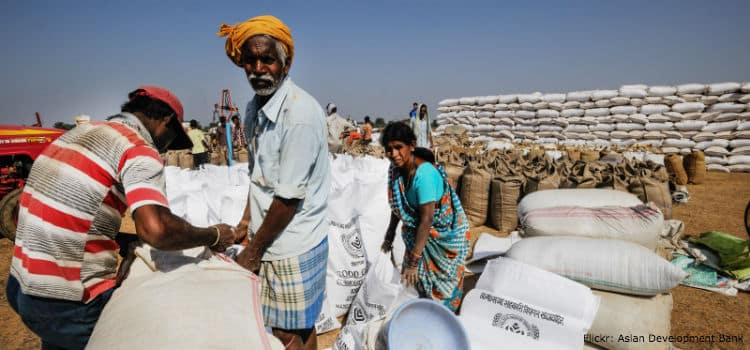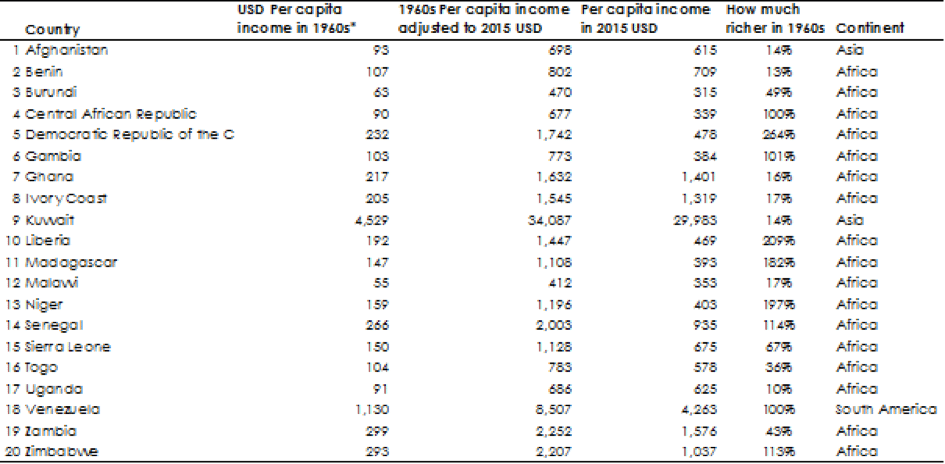At the Chhattisgarh Irrigation Development Project in India, poverty is alleviated with the help of improved irrigation services and agricultural resource management. | Flickr: Asian Development Bank
It is perhaps one of the most counterintuitive findings in our research, that the biggest problem with poverty alleviation programs is the fact that most of the programs work. Consider an organization that decides to alleviate poverty by providing free shoes, free food, or free schools to people in a poor community. The organization’s goal is to ease the pain and sufferings of the people in the communities where it works. As a result, it aligns its resources and processes accordingly. In providing these resources, it does ease the pain and suffering of the people in the community. But without an integrated approach to solving the actual cause of why the community is poor, the organization’s programs will be unsustainable and very expensive. And while the organization will alleviate poverty, it will leave many in the community still poor, as I’ve seen firsthand.
Some friends and I founded Poverty Stops Here in 2009 with the goal of alleviating poverty in communities where we worked. And we succeeded. We built wells, funded schools, and provided microloans to people in the community. We aligned our resources perfectly, and indeed alleviated poverty. But all the poor communities where we worked in 2009, and still work today, are still poor. That’s because when the goal of an organization is to alleviate poverty, it tends to lend itself to mediocrity. Consider an organization set up to achieve the United Nations Sustainable Development Goal 6: Ensure access to water and sanitation for all. As many organizations do today, building wells and toilets might seem like the right solution. But as I wrote in this post, many of those sorts of projects don’t have long-term and sustainable impact. Unfortunately, this is happening on a macro scale as well.
Since 1960, wealthy countries have spent more than $4.2 trillion trying to help poor countries alleviate poverty. The World Bank, one of the institutions working to end extreme poverty, is currently executing more than 1,600 projects totalling over $190 billion in 143 countries today. That amount is more than the GDP of all but three African countries. And, the World Bank is just one of the many other development institutions working to end or alleviate extreme poverty. By the World Bank’s estimation, less than two percent of all of its projects since 1970 are “highly likely” to be sustainable. But virtually all of them alleviate poverty.
When we assess the impact of many other institutions and their projects, we realize that, just like the World Bank projects, they do alleviate poverty, but in many cases still leave communities poor. Based on data from the International Monetary Fund, almost all poor countries in 1960 are still poor today. And some are actually poorer.
Table 1: List of 20 countries poorer today than they were in 1960
Source: IMF World Economic Outlook Database
So, how is it that an industry that is filled with some of the brightest minds in the world and spends hundreds of billions of US dollars a year is unable to have more of an impact? Our research suggests that it is because the industry is doing exactly what it is designed to do: alleviate poverty. But alleviating poverty, it turns out, is not good enough.
Defining the problem by asking the right questions
Famed Nobel Prize winning theoretical physicist, Albert Einstein, is quoted as saying, “If I had an hour to solve a problem, I’d spend the first 55 minutes thinking about the problem and five minutes thinking about solutions.” With that in in mind, we must start by asking the right questions. For instance, are we simply trying to alleviate poverty or are we working to create prosperity? If we are trying to alleviate poverty, then business as usual will prevail and billions of dollars will continue to be spent in an effort to help the world’s poorest. And as the data suggests, the world’s poorest are likely to remain poor. But if we change our question and reorient our thinking, then we are likely to develop more integrated and sustainable solutions. For instance, instead of asking, “How can we ensure water and sanitation for all,” we might want to ask, “Why do hundreds of millions of people not have water and why have our past interventions not worked as expected?” Honest answers to these questions will lead us to develop more integrated solutions that will take into consideration the circumstances in which people find themselves. By thoroughly understanding these circumstances, we are likely to develop more applicable solutions.
Second, once we reorient our thinking, we must consider models that have worked. In the 1950s and 1960s, Taiwan and South Korea were as poor or poorer than many African countries. But, through investments in market-creating innovations, they were able to create prosperity for many of their citizens. Market-creating innovations target nonconsumption and transform expensive and complicated products into simple and affordable products so that many people in society can afford them. For example, one of the largest plastics companies in the world today, Formosa Plastics of Taiwan, was funded largely through a $798,000 loan from USAID in the 1950s. Today, the company employs more than 10,000 people and has assets worth more than $13 billion. China, as controversial as their development strategy might be, is on the same track. Rather than implementing billions of US dollars worth of poverty alleviation projects, the country is building enterprises that are providing solutions for its citizens and the rest of the world. From the income and taxes generated from productive enterprise, the Chinese were able to meet all the Millennium Development Goals even though they were not a signatory to the UN pact.
Third, we must consider setting up a new unit that tackles development differently. Many of the largest development organizations are set up to alleviate poverty and it would be unrealistic to expect them to change overnight. However, Clayton Christensen, Harvard Business School professor and co-founder of the Christensen Institute, proposes that organizations should set up a new unit when they need to develop vastly different capabilities. If the World Bank and other development institutions set up a small unit that targeted market-creating innovations in poor countries, they would begin to model their development initiatives after those of countries that have worked. The results would not simply be a temporary alleviation of poverty, but potentially a permanent creation of prosperity.
But for all this to work, as counterintuitive as it might be, we must stop thinking about how to alleviate poverty. Instead, we should start thinking about how to create prosperity.




